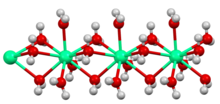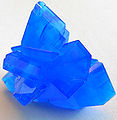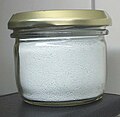Water of crystallization
In chemistry, water(s) of crystallization or water(s) of hydration are
Upon crystallization from water, or water-containing solvents, many compounds incorporate water molecules in their crystalline frameworks. Water of crystallization can generally be removed by heating a sample but the crystalline properties are often lost.
Compared to inorganic salts, proteins crystallize with large amounts of water in the crystal lattice. A water content of 50% is not uncommon for proteins.
Applications
Knowledge of hydration is essential for calculating the masses for many compounds. The reactivity of many salt-like solids is sensitive to the presence of water. The hydration and dehydration of salts is central to the use of
Position in the crystal structure

A salt with associated water of crystallization is known as a hydrate. The structure of hydrates can be quite elaborate, because of the existence of hydrogen bonds that define polymeric structures.[3] [4] Historically, the structures of many hydrates were unknown, and the dot in the formula of a hydrate was employed to specify the composition without indicating how the water is bound. Per IUPAC's recommendations, the middle dot is not surrounded by spaces when indicating a chemical adduct.[5] Examples:
- CuSO4·5H2O – copper(II) sulfate pentahydrate
- CoCl2·6H2O – cobalt(II) chloride hexahydrate
- SnCl2·2H2O – tin(II) (or stannous) chloride dihydrate
For many salts, the exact bonding of the water is unimportant because the water molecules are made labile upon dissolution. For example, an aqueous solution prepared from CuSO4·5H2O and anhydrous CuSO4 behave identically. Therefore, knowledge of the degree of hydration is important only for determining the equivalent weight: one mole of CuSO4·5H2O weighs more than one mole of CuSO4. In some cases, the degree of hydration can be critical to the resulting chemical properties. For example, anhydrous RhCl3 is not soluble in water and is relatively useless in organometallic chemistry whereas RhCl3·3H2O is versatile. Similarly, hydrated AlCl3 is a poor Lewis acid and thus inactive as a catalyst for Friedel-Crafts reactions. Samples of AlCl3 must therefore be protected from atmospheric moisture to preclude the formation of hydrates.

Crystals of hydrated copper(II) sulfate consist of [Cu(H2O)4]2+ centers linked to SO2−4 ions. Copper is surrounded by six oxygen atoms, provided by two different sulfate groups and four molecules of water. A fifth water resides elsewhere in the framework but does not bind directly to copper.
Consider the case of nickel(II) chloride hexahydrate. This species has the formula NiCl2(H2O)6. Crystallographic analysis reveals that the solid consists of [trans-NiCl2(H2O)4] subunits that are hydrogen bonded to each other as well as two additional molecules of H2O. Thus one third of the water molecules in the crystal are not directly bonded to Ni2+, and these might be termed "water of crystallization".
Analysis
The water content of most compounds can be determined with a knowledge of its formula. An unknown sample can be determined through thermogravimetric analysis (TGA) where the sample is heated strongly, and the accurate weight of a sample is plotted against the temperature. The amount of water driven off is then divided by the molar mass of water to obtain the number of molecules of water bound to the salt.
Other solvents of crystallization
Water is particularly common solvent to be found in crystals because it is small and polar. But all solvents can be found in some host crystals. Water is noteworthy because it is reactive, whereas other solvents such as benzene are considered to be chemically innocuous. Occasionally more than one solvent is found in a crystal, and often the stoichiometry is variable, reflected in the crystallographic concept of "partial occupancy". It is common and conventional for a chemist to "dry" a sample with a combination of vacuum and heat "to constant weight".
For other solvents of crystallization, analysis is conveniently accomplished by dissolving the sample in a
Table of crystallization water in some inorganic halides
In the table below are indicated the number of molecules of water per metal in various salts.[7][8]
| Hydrated metal halides and their formulas |
Coordination sphere of the metal |
Equivalents of water of crystallization that are not bound to M |
Remarks |
|---|---|---|---|
| Calcium chloride CaCl2(H2O)6 |
[Ca(μ-H2O)6(H2O)3]2+ | none | example of water as a bridging ligand[9] |
| Titanium(III) chloride TiCl3(H2O)6 |
trans-[TiCl2(H2O)4]+[10] | two | isomorphous with VCl3(H2O)6 |
| Titanium(III) chloride TiCl3(H2O)6 |
[Ti(H2O)6]3+[10] | none | isomeric with [TiCl2(H2O)4]Cl.2H2O[11] |
Zirconium(IV) fluoride ZrF4(H2O)3 |
(μ−F)2[ZrF3(H2O)3]2 | none | rare case where Hf and Zr differ[12] |
| Hafnium tetrafluoride HfF4(H2O)3 |
(μ−F)2[HfF2(H2O)2]n(H2O)n | one | rare case where Hf and Zr differ[12] |
| Vanadium(III) chloride VCl3(H2O)6 |
trans-[VCl2(H2O)4]+[10] | two | |
| Vanadium(III) bromide VBr3(H2O)6 |
trans-[VBr2(H2O)4]+[10] | two | |
| Vanadium(III) iodide VI3(H2O)6 |
[V(H2O)6]3+ | none | relative to Cl− and Br−, I− competes poorly with water as a ligand for V(III) |
| Nb6Cl14(H2O)8 | [Nb6Cl14(H2O)2] | four | |
| Chromium(III) chloride CrCl3(H2O)6 |
trans-[CrCl2(H2O)4]+ | two | dark green isomer, aka "Bjerrums's salt" |
| Chromium(III) chloride CrCl3(H2O)6 |
[CrCl(H2O)5]2+ | one | blue-green isomer |
| Chromium(II) chloride CrCl2(H2O)4 |
trans-[CrCl2(H2O)4] | none | square planar/tetragonal distortion |
| Chromium(III) chloride CrCl3(H2O)6 |
[Cr(H2O)6]3+ | none | violet isomer. isostructural with aluminium compound[13] |
Aluminum trichloride AlCl3(H2O)6 |
[Al(H2O)6]3+ | none | isostructural with the Cr(III) compound |
| Manganese(II) chloride MnCl2(H2O)6 |
trans-[MnCl2(H2O)4] | two | |
| Manganese(II) chloride MnCl2(H2O)4 |
cis-[MnCl2(H2O)4] | none | cis molecular, the unstable trans isomer has also been detected[14] |
| Manganese(II) bromide MnBr2(H2O)4 |
cis-[MnBr2(H2O)4] | none | cis, molecular |
| Manganese(II) iodide MnI2(H2O)4 |
trans-[MnI2(H2O)4] | none | molecular, isostructural with FeCl2(H2O)4.[15] |
| Manganese(II) chloride MnCl2(H2O)2 |
trans-[MnCl4(H2O)2] | none | polymeric with bridging chloride |
| Manganese(II) bromide MnBr2(H2O)2 |
trans-[MnBr4(H2O)2] | none | polymeric with bridging bromide |
| Iron(II) chloride FeCl2(H2O)6 |
trans-[FeCl2(H2O)4] | two | |
| Iron(II) chloride FeCl2(H2O)4 |
trans-[FeCl2(H2O)4] | none | molecular |
| Iron(II) bromide FeBr2(H2O)4 |
trans-[FeBr2(H2O)4] | none | molecular,[16] hydrates of FeI2 are not known |
| Iron(II) chloride FeCl2(H2O)2 |
trans-[FeCl4(H2O)2] | none | polymeric with bridging chloride |
| Iron(III) chloride FeCl3(H2O)6 |
trans-[FeCl2(H2O)4]+ | two | one of four hydrates of ferric chloride,[17] isostructural with Cr analogue
|
| Iron(III) chloride FeCl3(H2O)2.5 |
cis-[FeCl2(H2O)4]+ | two | the dihydrate has a similar structure, both contain FeCl−4 anions.[17] |
| Cobalt(II) chloride CoCl2(H2O)6 |
trans-[CoCl2(H2O)4] | two | |
| Cobalt(II) bromide CoBr2(H2O)6 |
trans-[CoBr2(H2O)4] | two | |
| Cobalt(II) iodide CoI2(H2O)6 |
[Co(H2O)6]2+ | none[18] | iodide competes poorly with water |
| Cobalt(II) bromide CoBr2(H2O)4 |
trans-[CoBr2(H2O)4] | none | molecular[16] |
| Cobalt(II) chloride CoCl2(H2O)4 |
cis-[CoCl2(H2O)4] | none | note: cis molecular |
| Cobalt(II) chloride CoCl2(H2O)2 |
trans-[CoCl4(H2O)2] | none | polymeric with bridging chloride |
| Cobalt(II) chloride CoBr2(H2O)2 |
trans-[CoBr4(H2O)2] | none | polymeric with bridging bromide |
| Nickel(II) chloride NiCl2(H2O)6 |
trans-[NiCl2(H2O)4] | two | |
| Nickel(II) chloride NiCl2(H2O)4 |
cis-[NiCl2(H2O)4] | none | note: cis molecular[16] |
| Nickel(II) bromide NiBr2(H2O)6 |
trans-[NiBr2(H2O)4] | two | |
| Nickel(II) iodide NiI2(H2O)6 |
[Ni(H2O)6]2+ | none[18] | iodide competes poorly with water |
| Nickel(II) chloride NiCl2(H2O)2 |
trans-[NiCl4(H2O)2] | none | polymeric with bridging chloride |
| Platinum(IV) chloride [Pt(H2O)2Cl4](H2O)3[19] |
trans-[PtCl4(H2O)2] | 3 | octahedral Pt centers; rare example of non-first row chloride-aquo complex |
| Platinum(IV) chloride [Pt(H2O)3Cl3]Cl(H2O)0.5[20] |
fac-[PtCl3(H2O)3]+ | 0.5 | octahedral Pt centers; rare example of non-first row chloride-aquo complex |
| Copper(II) chloride CuCl2(H2O)2 |
[CuCl4(H2O)2]2 | none | tetragonally distorted two long Cu-Cl distances |
| Copper(II) bromide CuBr2(H2O)4 |
[CuBr4(H2O)2]n | two | tetragonally distorted two long Cu-Br distances[16] |
| 2 ZnCl2 + ZnCl2(H2O)4 | none | coordination polymer with both tetrahedral and octahedral Zn centers | |
| Cl3Zn(μ-Cl)Zn(H2O)5 | none | tetrahedral and octahedral Zn centers | |
| [ZnCl4]2− + Zn(H2O)6]2+ | none | tetrahedral and octahedral Zn centers | |
| [ZnCl4]2− + [Zn(H2O)6]2+ | three | tetrahedral and octahedral Zn centers |
Hydrates of metal sulfates

Transition metal sulfates form a variety of hydrates, each of which crystallizes in only one form. The sulfate group often binds to the metal, especially for those salts with fewer than six
| Formula of hydrated metal ion sulfate |
Coordination sphere of the metal ion |
Equivalents of water of crystallization that are not bound to M |
mineral name | Remarks |
|---|---|---|---|---|
| MgSO4(H2O) | [Mn(μ-H2O)(μ4,-κ1-SO4)4][26] | none | kieserite | see Mn, Fe, Co, Ni, Zn analogues |
| MgSO4(H2O)4 | [Mg(H2O)4(κ′,κ1-SO4)]2 | none | sulfate is bridging ligand, 8-membered Mg2O4S2 rings[27] | |
| MgSO4(H2O)6 | [Mg(H2O)6] | none | hexahydrate | common motif[24] |
| MgSO4(H2O)7 | [Mg(H2O)6] | one | epsomite | common motif[24] |
| TiOSO4(H2O) | [Ti(μ-O)2(H2O)(κ1-SO4)3] | none | further hydration gives gels | |
| VSO4(H2O)6 | [V(H2O)6] | none | Adopts the hexahydrite motif[28] | |
| VOSO4(H2O)5 | [VO(H2O)4(κ1-SO4)4] | one | ||
| Cr(SO4)(H2O)3 | [Cr(H2O)3(κ1-SO4)] | none | resembles Cu(SO4)(H2O)3[29] | |
| Cr(SO4)(H2O)5 | [CR(H2O)4(κ1-SO4)2] | one | resembles Cu(SO4)(H2O)5[30] | |
| Cr2(SO4)3(H2O)18 | [Cr(H2O)6] | six | One of several chromium(III) sulfates | |
| MnSO4(H2O) | [Mn(μ-H2O)(μ4,-κ1-SO4)4][26] | none | szmikite | see Fe, Co, Ni, Zn analogues |
| MnSO4(H2O)4 | [Mn(μ-SO4)2(H2O)4][31] | none | Ilesitepentahydrate is called jôkokuite; the hexahydrate, the most rare, is called chvaleticeite | with 8-membered ring Mn2(SO4)2 core |
| MnSO4(H2O)5 | ? | jôkokuite | ||
| MnSO4(H2O)6 | ? | Chvaleticeite | ||
| MnSO4(H2O)7 | [Mn(H2O)6] | one | mallardite[25] | see Mg analogue |
| FeSO4(H2O) | [Fe(μ-H2O)(μ4-κ1-SO4)4][26] | none | see Mn, Co, Ni, Zn analogues | |
| FeSO4(H2O)7 | [Fe(H2O)6] | one | melanterite[25] | see Mg analogue |
| FeSO4(H2O)4 | [Fe(H2O)4(κ′,κ1-SO4)]2 | none | sulfate is bridging ligand, 8-membered Fe2O4S2 rings[27] | |
| FeII(FeIII)2(SO4)4(H2O)14 | [FeII(H2O)6]2+[FeIII(H2O)4(κ1-SO4)2]− 2 |
none | sulfates are terminal ligands on Fe(III)[32] | |
| CoSO4(H2O) | [Co(μ-H2O)(μ4-κ1-SO4)4][26] | none | see Mn, Fe, Ni, Zn analogues | |
| CoSO4(H2O)6 | [Co(H2O)6] | none | moorhouseite | see Mg analogue |
| CoSO4(H2O)7 | [Co(H2O)6] | one | bieberite[25] | see Fe, Mg analogues |
| NiSO4(H2O) | [Ni(μ-H2O)(μ4-κ1-SO4)4][26] | none | see Mn, Fe, Co, Zn analogues | |
| NiSO4(H2O)6 | [Ni(H2O)6] | none | retgersite | One of several nickel sulfate hydrates[33] |
| NiSO4(H2O)7 | [Ni(H2O)6] | morenosite[25] | ||
| (NH4)2[Pt2(SO4)4(H2O)2] | [Pt2(SO4)4(H2O)2]2- | none | Pt-Pt bonded Chinese lantern structure[34] | |
| CuSO4(H2O)5 | [Cu(H2O)4(κ1-SO4)2] | one | chalcantite | sulfate is bridging ligand[35] |
| CuSO4(H2O)7 | [Cu(H2O)6] | one | boothite[25] | |
| ZnSO4(H2O) | [Zn(μ-H2O)(μ4-κ1-SO4)4][26] | none | see Mn, Fe, Co, Ni analogues | |
| ZnSO4(H2O)4 | [Zn(H2O)4(κ′,κ1-SO4)]2 | none | sulfate is bridging ligand, 8-membered Zn2O4S2 rings[27][36] | |
| ZnSO4(H2O)6 | [Zn(H2O)6] | none | see Mg analogue[37] | |
| ZnSO4(H2O)7 | [Zn(H2O)6] | one | goslarite[25] | see Mg analogue |
| CdSO4(H2O) | [Cd(μ-H2O)2(κ1-SO4)4] | none | bridging water ligand[38] |
Hydrates of metal nitrates
| Formula of hydrated metal ion nitrate |
Coordination sphere of the metal ion |
Equivalents of water of crystallization that are not bound to M |
Remarks |
|---|---|---|---|
| Cr(NO3)3(H2O)9 | [Cr(H2O)6]3+ | three | octahedral configuration[39] isostructural with Fe(NO3)3(H2O)9 |
| Mn(NO3)2(H2O)4 | cis-[Mn(H2O)4(κ1-ONO2)2] | none | octahedral configuration |
| Mn(NO3)2(H2O) | [Mn(H2O)(μ-ONO2)5] | none | octahedral configuration |
| Mn(NO3)2(H2O)6 | [Mn(H2O)6] | none | octahedral configuration[40] |
| Fe(NO3)3(H2O)9 | [Fe(H2O)6]3+ | three | octahedral configuration[41] isostructural with Cr(NO3)3(H2O)9 |
| Fe(NO3)3)(H2O)4 | [Fe(H2O)3(κ2-O2NO)2]+ | one | pentagonal bipyramid[42]
|
| Fe(NO3)3(H2O)5 | [Fe(H2O)5(κ1-ONO2)]2+ | none | octahedral configuration[42] |
| Fe(NO3)3(H2O)6 | [Fe(H2O)6]3+ | none | octahedral configuration[42] |
| Co(NO3)2(H2O)2 | [Co(H2O)2(κ1-ONO2)2] | none | octahedral configuration |
| Co(NO3)2(H2O)4 | [Co(H2O)4(κ1-ONO2)2 | none | octahedral configuration |
| Co(NO3)2(H2O)6 | [Co(H2O)6]2+ | none | octahedral configuration.[43] |
| α-Ni(NO3)2(H2O)4 | cis-[Ni(H2O)4(κ1-ONO2)2] | none | octahedral configuration.[44] |
| β-Ni(NO3)2(H2O)4 | trans-[Ni(H2O)4(κ1-ONO2)2] | none | octahedral configuration.[45] |
| Pd(NO3)2(H2O)2 | trans-[Pd(H2O)2(κ1-ONO2)2] | none | square planar coordination geometry[46]
|
| Cu(NO3)2(H2O) | [Cu(H2O)(κ2-ONO2)2] | none | octahedral configuration. |
| Cu(NO3)2(H2O)1.5 | uncertain | uncertain | uncertain[47] |
| Cu(NO3)2(H2O)2.5 | [Cu(H2O)2(κ1-ONO2)2] | one | square planar[48] |
| Cu(NO3)2(H2O)3 | uncertain | uncertain | uncertain [49] |
| Cu(NO3)2(H2O)6 | [Cu(H2O)6]2+ | none | octahedral configuration[50] |
| Zn(NO3)2(H2O)4 | cis-[Zn(H2O)4(κ1-ONO2)2] | none | octahedral configuration. |
Hg2(NO3)2(H2O)2 |
[H2O–Hg–Hg–OH2]2+ | linear[51] |
Photos
-
Hydrated copper(II) sulfate is bright blue.
-
Anhydrous copper(II) sulfate has a light turquoise tint.
See also
References
- ISBN 978-0-08-037941-8.
- .
- PMID 12444778.
- .
- ISBN 0-85404-438-8. Retrieved 10 January 2023.
- ISBN 978-0-12-503350-3. Retrieved 15 June 2014.
- .
- .
- S2CID 97718377.
- ^ .
- ISBN 978-0-08-037941-8.
- ^ ISBN 978-0-08-037941-8.
- ^ Andress, K. R.; Carpenter, C. (1934). "Die Struktur von Chromchlorid- und Aluminiumchloridhexahydrat". Zeitschrift für Kristallographie, Kristallgeometrie, Kristallphysik, Kristallchemie. 87: 446–463.
- .
- .
- ^ .
- ^ S2CID 105925459.
- ^ .
- .
- .
- ^ .
- PMID 25552980.
- .
- ^ .
- ^ S2CID 95885758.
- ^ a b c d e f g Wildner, M.; Giester, G. (1991). "The Crystal Structures of Kieserite-type Compounds. I. Crystal Structures of Me(II)SO4·H2O (Me = Mn, Fe, Co, Ni, Zn) (English translation)". Neues Jahrbuch für Mineralogie - Monatshefte: 296–306.
{{cite journal}}: CS1 maint: multiple names: authors list (link) - ^ .
- .
- .
- .
- S2CID 62599961.
- ^ L. Fanfani; A. Nunzi; P. F. Zanazzi (1970). "The Crystal Structure of Roemerite". American Mineralogist. 55: 78–89.
- .
- .
- doi:10.1039/B918702B
- .
- .
- PMID 26594423.)
{{cite journal}}: CS1 maint: multiple names: authors list (link - .
- S2CID 97491858.
- .
- ^ PMID 22669180.
- ^ Prelesnik, P. V.; Gabela, F.; Ribar, B.; Krstanovic, I. (1973). "Hexaaquacobalt(II) nitrate". Cryst. Struct. Commun. 2 (4): 581–583.
- .
- .
- .
- .
- .
- ^ J. Garaj, Sbornik Prac. Chem.-Technol. Fak. Svst., Cskosl. 1966, pp. 35–39.
- .
- .


